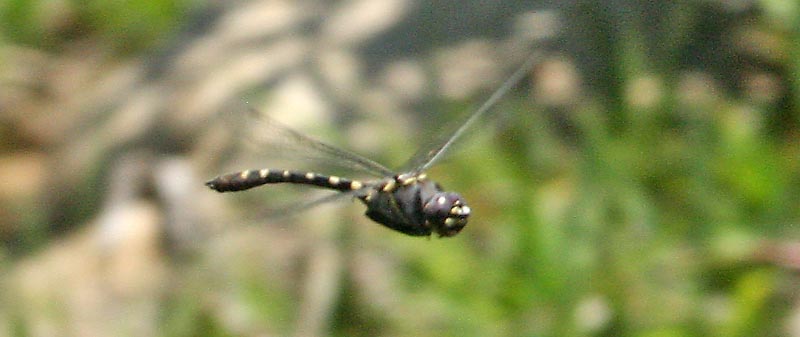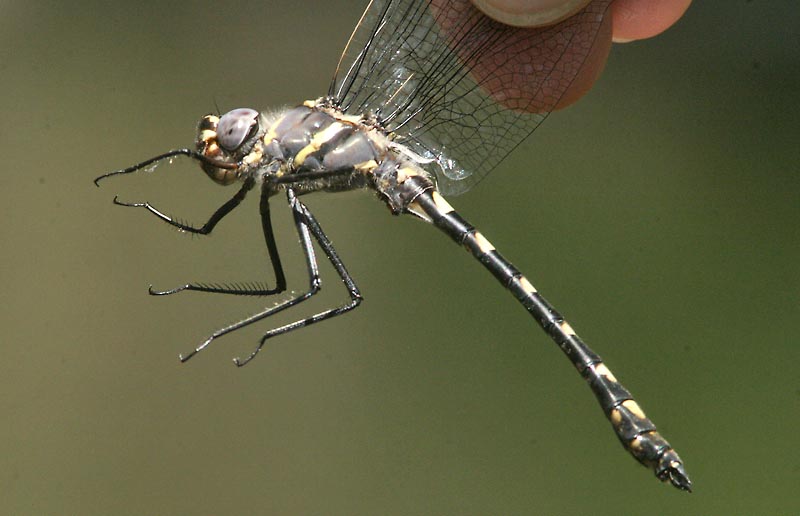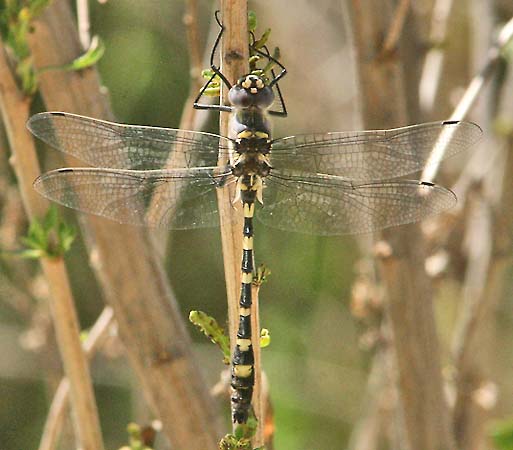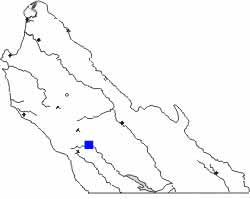WESTERN RIVER
CRUISER
Macromia
magnifica
|
|
Western River Cruiser is a large, fast,
impressive dragonfly that patrols long stretches of rivers that have
riffles and ponds. Its discovery in Monterey County in May 2007 was
unexpected, as the nearest populations were ~100 miles to the north in
the Diablo Range, or ~120 miles to the east in the Sierra Nevada, and
represented the southernmost record in the Coast Ranges.
|

Western River Cruiser is the only member of the
family Macromiidae (sometimes considered a subfamily) in California. It
is quite large — 3 inches long with a 4 inch wingspan — and thus is
larger than all darners, except Giant Darner (which is blue and green,
not gray and yellow). The Cruiser resembles only Pacific Spiketail,
which also patrols long stretches of rivers or roads and has a
black-and-yellow abdomen. The cruiser differs in having a gray thorax
with only a single yellow side stripe (the spiketail has two side
stripes), gray eyes (not aqua blue), a prominent T-spot on the frons,
and a different pattern of yellow spots on the abdomen. Males (above)
have 'clubbed' tip of the abdomen and hold their abdomen in a slight
arch in flight. When perched (below) the gray eyes meet more broadly
atop the head than due the barely-touching eyes of spiketails. Cruisers
have very long legs, even as larvae.
|
|
All photos 6 May
2007 North fork San Antonio River
|
|
|
|
Manolis (2003) writes: "Cruisers are named
for their fast and powerful flight and the males' habit of patrolling
long beats down streams and rivers. Both sexes forage on the wing with
great speed and agility, high and low, near and far from water. They
are seldom seen perched and are difficult to follow — and even harder
to catch."
Hard to catch? Possibly at most places at
most times. But when Don Roberson & Paul Johnson found MTY's first
cruiser on the San Antonio River, it took Paul only one swing of net
the very fearless male that was patrolling low over this shallow pond
(below; Paul is removing the dragon from the net in this shot). The
in-hand photos on this page are from that capture; more photos about
the discovery of this species in MTY and the specific locale are elsewhere on
this web site.

|
|
 |
|
When the do perch, cruisers hang vertically
from trees or small bushes. When releasing our netted male, we placed
it on a perch that it used for a short while (right) until it flew to
another (below) for multiple photos. Whether at perch or in flight,
this is one very striking dragonfly!
There are 7 species of river cruiser in
North America; Western River Cruiser is the only one west of the
Rockies. Those in the east can be difficult to identify (e.g., Beaton
2007) and observers focus on whether the yellow ring on segment 2 is
broken dorsally (as it is on our ode) and whether the spot atop segment
3 touches the yellow lateral stripe underneath (it does not on our
species). We are fortunate that we do not have these tricky
identification problems here!
|

|
|
|
|
|
River cruisers are among the fastest fliers of all
odonates. Bold and aggressive, they are very impressive in flight. This
flight shot (below) was taken by Paul Johnson of MTY's first record.
|
|
|
|
 The map shows the only locale
from which Western River Cruiser is currently known in MTY: along the
North fork of the San Antonio River near Wagon Caves, Los Padres NF. The map shows the only locale
from which Western River Cruiser is currently known in MTY: along the
North fork of the San Antonio River near Wagon Caves, Los Padres NF.
In MTY, Western River Cruiser was discovered
6 May 2007 and seen again through 13 May at the San Antonio River site.
Elsewhere, flight dates range from mid-April to early September
(Manolis 2003).
|
|
Literature cited:
- Beaton, G. 2007. Dragonflies and Damselflies of
Georgia and the Southeast. Univ. of Georgia Press, Athens, GA.
- Manolis, T. 2003. Dragonflies and Damselflies of
California. Univ. of Calif. Press, Berkeley.
Web resources:
Major identification web sites with much information on California
odes include:
For sites with excellent photos to compare for identification or to
simply
enjoy, see:
Many of these sites have links to other useful pages. Kathy Biggs's
site
is particularly useful in her selection of links. |
